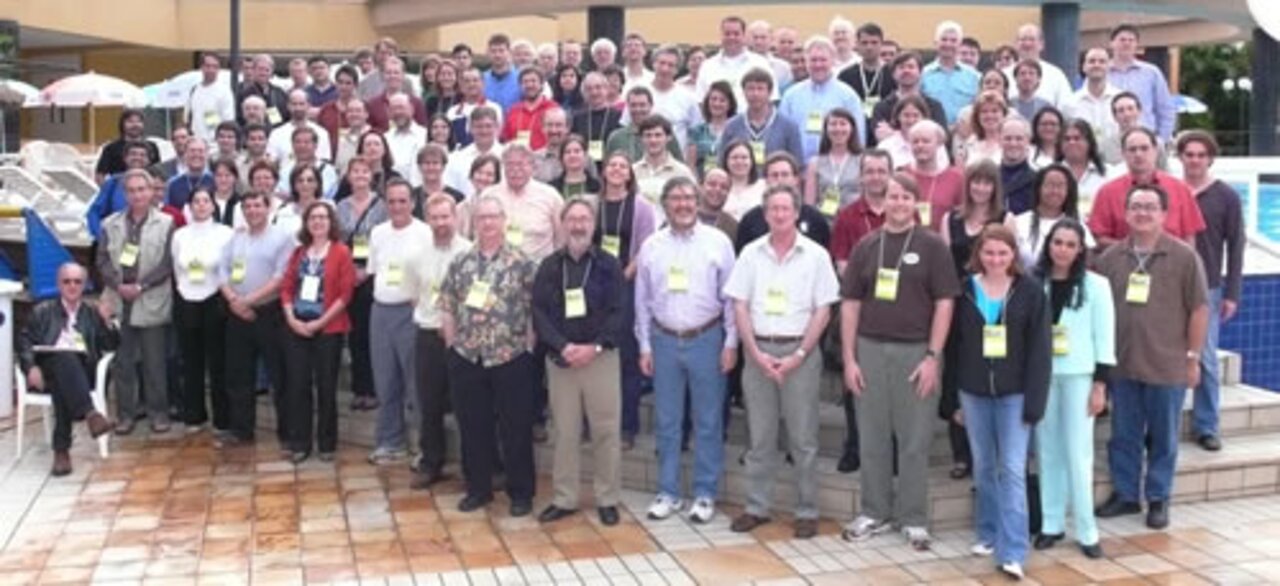Astronomers Converge in Brazil for 2007 Gemini Science Meeting
June 18, 2007

Amidst the stunning beauty of the Foz do Iguaçu park and waterfalls in Brazil, more than 130 astronomers and staff from the seven-country Gemini partnership converged during the week of June 11th, 2007 to discuss current results, capabilities and future research and collaborations.
The Laboratório Nacional de Astrofísica (LNA), acting as the Brazilian National Gemini Office, was responsible for the local organization of the meeting. Foz de Iguaçu was chosen as the meeting place because it combines a desirable tourist attraction – the Iguaçu-Falls are among the most stunning natural displays on earth – with excellent infra-structure for international conventions. “We are very satisfied that the Gemini Board accepted the offer of LNA to host the Gemini Science Meeting in Brazil,” said Albert Bruch, chair of the Local Organizing Committee. “Among several options we choose a prime meeting place which from the very beginning gave us confidence that the participating scientists would find the agreeable surrounding as well as the comfort and service which are indispensable for a successful and fruitful congress. These expectations were entirely fulfilled according to the responses expressed by many participants.”
The Scientific Organizing Committee worked under the lead of Verne Smith, Director of the NOAO Gemini Science Center. All major themes of current forefront astrophysical research were covered by the 60 oral talks and about 45 posters. Several specific Gemini tools like mid-infrared capabilities, the several integral field units for spectroscopic mapping, (especially when fed by adaptive optics), were shown by the spectacular results presented at the meeting. These results demonstrate the extremely power these capabilities deliver on 8-m telescopes optimized for infrared observations and high spatial resolution. Many remarkable results were presented at Foz, and the following is a small sample:
- Latest results from the Gemini Deep Deep Survey confirm that more than 50% of the stars in galaxies had been formed by redshift z = 1. This opens the curious enigma of finding where and how most of the rest of current stars were formed in the last half of the history of the universe.
- The queue mode of Gemini continues to play a crucial role in the follow-up spectroscopy of distant supernovae used to determine the rate of acceleration of the universe around redshift z = 1.
- The partly complete Gemini Planet Survey puts new statistical constraints on the number and masses of large Jovian planets around nearby young stars.
- UKIDSS (UKIRT Infrared Deep Sky Survey) is revealing an exciting population of very low mass brown dwarfs and candidate high redshift galaxy clusters.
- The extended emission regions around certain quasars store masses up to several tens of billions of solar masses and appear to originate from recent gigantic explosions in the central regions of black hole surroundings.
- Gemini mid-infrared imagers, T-ReCS and MICHELLE, are allowing the detailed spatial exploration of the dusty central regions of active galaxy nuclei in unique ways.
- There is a rich population of massive star clusters of age around 150 million years located away from the central bursting region of the starburst galaxy M82.
- Several exciting results on old and recent supernova demonstrate that a new astrophysical discipline is on the rise: “supernova forensics.” Image and spectra of supernovae that exploded a few years ago in several nearby galaxies reveal tantalizing details on the nature of their progenitors. GMOS spectroscopy of light echoes of centuries-old supernovae in the LMC and in the Milky Way present huge promises in our ability to related known supernova remnants to the their progenitors.
- Detailed spatio-kinematics with PHOENIX of the massive gas and dust envelope surrounding Eta Carinae unravel in the finest detail the successive phases of the spectacular eruptions the star underwent in the 19th century.
- Using the GMOS IFU, intermediate mass black holes have been identified at the center a few galactic globular clusters.
- Very careful analysis and handling of the mid-infrared point-spread-function have allowed the discovery and characterization of several circumstellar disks around young stars.
- MICHELLE is turning out to be a most powerful tool in characterizing the atmospheres of outer solar system planets. Combined mid-infrared observations and adaptive optics imaging, this allows astronomers to follow the active meteorological cycles of the large solar system icy planets.
- Time and space resolved spectroscopy of the Deep Impact event in July 2005 has revealed that Jupiter-family comets may be closely related to Oort Cloud comets.
For more information on this meeting and its participants, see the supporting website at: http://www.lna.br/~gsm2007/
After the three-day science conference, a lively and successful Gemini Users’ Meeting was held where many of the science conference participants, National Gemini Offices and Gemini Observatory staff reviewed and discussed a range of topics that included: current science operations, efficiency of systems, science productivity, present and future instrumentation, time allocation process, enabling a greater number of large observing programs, etc. On the fifth day, more than 30 members of the Gemini Science Staff and National Gemini Office Staff met to review many issues related to the support of our users community and to define ways to better serve our users.


